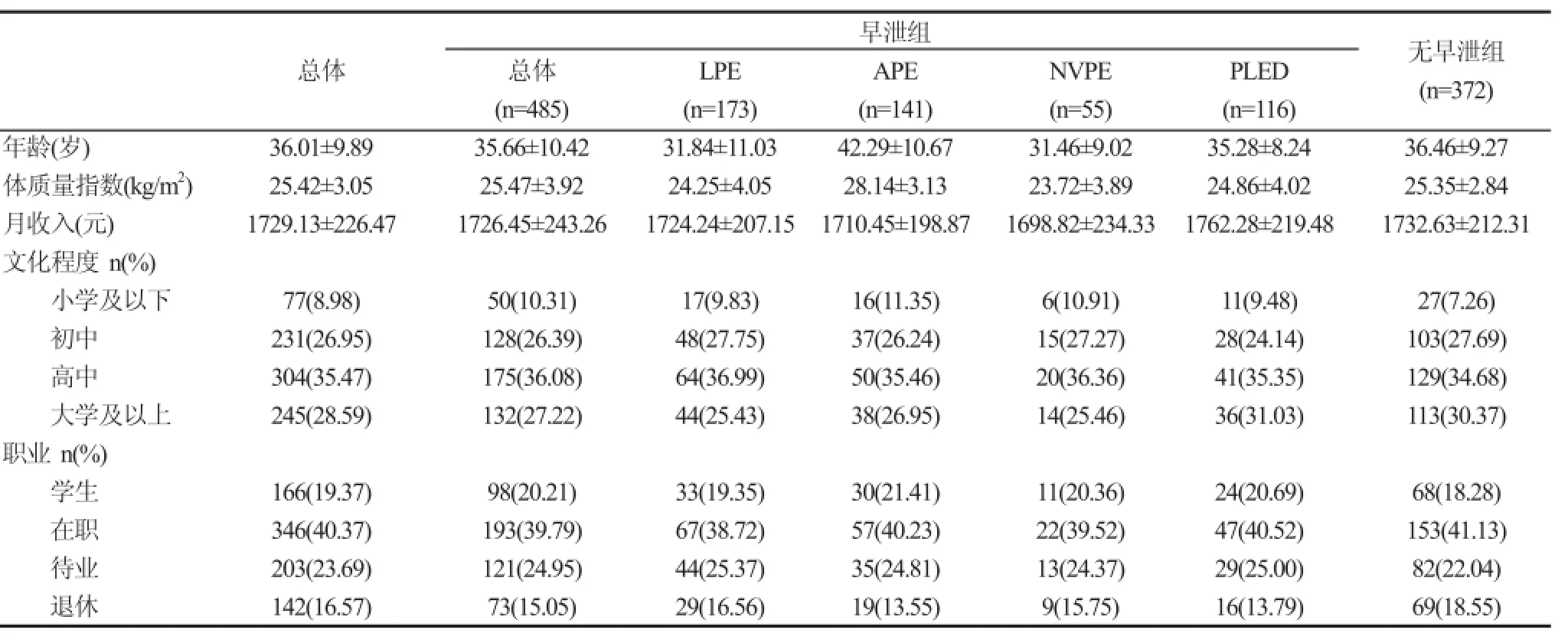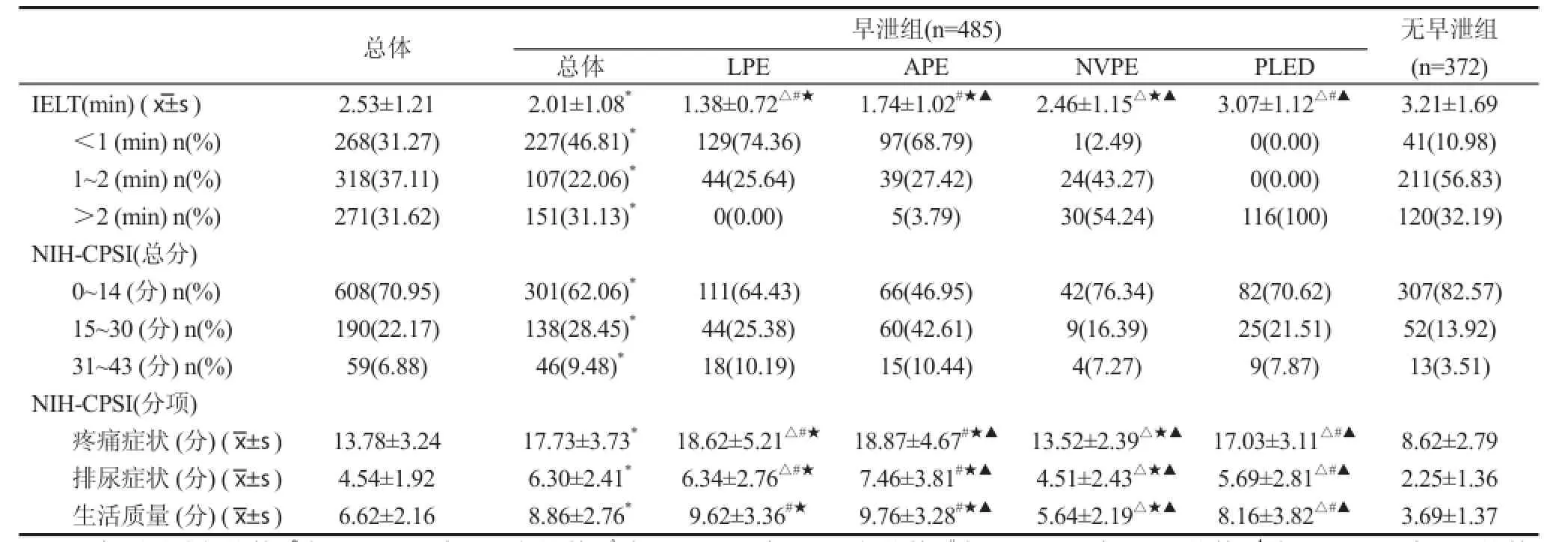不同类型早泄射精潜伏期与慢性前列腺炎症状评分的相关性调查*
2015-08-01张贤生高晶晶汤冬冬杨佳佳史黄远远郝宗耀梁朝朝安徽医科大学第一附属医院泌尿外科合肥230022
许 传 张贤生高晶晶 汤冬冬 杨佳佳史 凯 高 攀 黄远远 郝宗耀 周 骏 梁朝朝安徽医科大学第一附属医院泌尿外科 (合肥 230022)
不同类型早泄射精潜伏期与慢性前列腺炎症状评分的相关性调查*
许 传 张贤生**高晶晶 汤冬冬 杨佳佳史 凯 高 攀 黄远远 郝宗耀 周 骏 梁朝朝
安徽医科大学第一附属医院泌尿外科 (合肥 230022)
摘要目的 探讨不同类型早泄射精潜伏期(IELT)与美国国立卫生研究院前列腺炎症状评分(NIH-CPSI)的相关性。方法 对2013年2月至2014年5月因早泄而就诊于安徽医科大学第一附属医院男科门诊的485名早泄患者和372名健康体检者(来自体检中心,自述无早泄)进行相关检查和问卷调查。调查的内容包括基本人口信息学特征、IELT和NIH-CPSI等。结果 早泄组的IELT显著低于自述无早泄组(简称无早泄组),而早泄组的NIH-CPSI评分显著高于无早泄组。在不同类型早泄组中,获得性早泄(APE)的NIH-CPSI的总分及各分项得分值最高,早泄样射精功能障碍(PLED)的IELT最长。早泄患者的IELT与NIH-CPSI评分呈负相关性,其中APE组的IELT与NIHCPSI总分及各分项得分的相关性最强:IELT与NIH-CPSI总分、疼痛症状评分、排尿症状评分、生活质量评分的相关系数分别为-0.67、-0.71、-0.69、-0.63(P均<0.001)。结论 早泄患者的NIH-CPSI评分显著高于无早泄组,早泄患者的IELT与NIH-CPSI评分呈负相关性,APE组的IELT与NIH-CPSI总分及各分项得分的负相关性最强。
关键词早泄; 前列腺炎症状评分
早泄是常见的男性性功能障碍,据研究报道,其发病率大约在20%~30%[1]。对于早泄的定义相关的专业组织有不同的定义及分类标准,国际性医学会(International Society for Sexual Medicine, ISSM)定义原发性早泄(lifelong premature ejaculation, LPE)为射精潜伏期(intravaginal ejaculatory latency time, IELT)<1min,缺乏控制射精的能力,因此带来了消极的情绪[2]。然而也有部分患者抱怨过早射精却不符合此早泄的定义,Waldinger 和Schweitzer等[3, 4]在此基础上增加了另外两种早泄分类,分别为自然变异性早泄(natural variable premature ejaculation, NVPE)和早泄样射精功能障碍(premature-like ejaculatory dysfunction, PLED)。依据此分类,我们的前期研究[5]调查了门诊早泄患者的分布情况,并得出LPE是门诊最常见的早泄类型,获得性早泄(acquired premature ejaculation, APE)往往伴有更多的合并症,如勃起功能障碍、高血压和糖尿病等。
早泄的发病与诸多因素有关,包括精神心理因素、勃起功能障碍和慢性前列腺炎等。相关研究[6-8]认为前列腺炎症状可能通过引起疼痛和下尿路症状间接影响男性的生殖健康。Screponi等[9]首次报道了早泄与慢性前列腺炎之间的相关性。此外,Lotti 等[10]在调查了244名不育男性后发现早泄的发病率与前列腺炎症状有明显的相关性,即早泄诊断量表(PE diagnostic tool, PEDT)得分与慢性前列腺炎症状评分(national institutes of health-chronic prostatitis symptom index, NIH-CPSI)的总分及各分项值呈正相关性,在NIH-CPSI分值≥4分时,早泄的发病风险增高(OR=6.41,P<0.0001)。上述研究表明早泄的发病可能与慢性前列腺炎相关,但对于不同类型早泄患者射精潜伏期与慢性前列腺炎症状评分的相关性研究较少,本研究旨在探讨不同类型早泄患者IELT与NIH-CPSI评分的相关性。
资料与方法
一、调查对象
调查对象为2013年2月到2014年5月因早泄来我院门诊的患者485名(早泄组)及我院体检中心健康自述无早泄者372名(简称无早泄组),所有调查对象获悉知情同意后均填写一份问卷,其内容主要包括基本的人口信息学(年龄、体质量指数、学历、职业等)和IELT、NIH-CPSI评分等
二、判断标准
(一)早泄的诊断
依据Waldinger等[3, 11]提出的早泄分类标准,将早泄患者分为原发性早泄(LPE)、继发性早泄(APE)、自然变异性早泄(NVPE)和早泄样射精功能障碍(PLED)4种类型,见表1。

表1 4种早泄类型的分类标准
(二)美国国立卫生研究院前列腺炎症状评分指数表(NIH-CPSI)
NIH-CPSI是一种被公认实用而可靠的前列腺炎症状自评表,评分内容包括:疼痛症状评分(共21分)、排尿症状评分(共10分)和症状对患者生活质量的影响(共12分)。CPSI评分按0~14分、15~30分、31~43分把症状及影响程度相应分为:轻度、中度、重度。
三、调查方法
调查者为经统一培训的泌尿男科医师,由调查人员向调查对象介绍调查内容和意义,调查对象在知情同意后独立完成问卷。对文化程度低者,由调查人员逐条解释并根据调查对象口述真实填写。
四、统计学方法
将所得数据进行整理、录入和核对,数据经审核其有效性及完整性后,通过SPSS 13.0(SPSS Inc., Chicago, United States)软件进行分析。用描述性统计学方法,t检验和方差分析用于多组数据的均数比较,x2检验用于多组数据率的比较,偏相关分析用于分析IELT和NIH-CPSI评分的相关性。以P<0.05作为差异具有显著性的判别标准。
结 果
一、人口统计学特点
早泄组和无早泄组患者的平均年龄分别为(35.66±10.42)岁和(36.46±9.27)岁,体质量指数分别为(25.47±3.92)kg/m2和(25.35±2.84)kg/m2,两组间无显著性差异。此外月收入、学历和职业等基本情况两组间无显著性差异。两组具有可比性,早泄组及无早泄组的基本情况见表2。

表2 早泄组和无早泄组患者一般情况的比较
二、早泄组和无早泄组的IELT和NIH-CPSI评分的结果比较
早泄组和无早泄组的IELT和NIH-CPSI的结果具有显著性差异,早泄组患者的IELT为(2.01±1.08)min,而无早泄组为(3.21±1.69)min。早泄组患者的IELT的分布为<1min约46.81%(227/485),1~2min占22.06% (107/485),>2min占31.13%(151/485);而无早泄组的IELT的分布为<1min约10.98%(41/372),~2min占56.83%(211/372),>2min占32.19% (120/372)。此外,早泄组患者的NIH-CPSI的总分值及各分项的分值显著高于无早泄组患者,见表3。
三、不同类型早泄患者的IELTIELT和NIH-CPSI-CPSI评分的结果比较
在早泄组中,不同类型早泄患者的IELT和NIHCPSI评分结果也有显著性差异。其中LPE组患者的IELT时间最短,为(1.38±0.72)min,而PLED组的平均IELT为(3.07±1.12)min。进一步分析发现,APE组NIH-CPSI评分在15~30分和31~43分的得分区间的比率显著高于其他3组,分别占42.61%,10.44%,差异具统计学意义(P<0.001),见表3。
四、IELTIELT和NIH-CPSI-CPSI评分的相关性分析
通过分析发现,早泄患者的IELT和NIH-CPSI评分之间具有相关性。在校正年龄的影响后,早泄患者IELT与NIH-CPSI的总分及各分项值呈负相关性,IELT 与NIH-CPSI总分(adjusted r =-0.56, P<0.001),IELT与疼痛症状评分(adjusted r =-0.59, P<0.001),IELT与排尿症状评分(adjusted r =-0.55, P<0.001),IELT与生活质量评分(adjusted r =-0.57, P<0.001)。此外,不同类型早泄组的IELT与NIH-CPSI评分也呈负相关性(P均<0.001)。其中,APE组IELT与NIHCPSI的总分及各分项值呈负相关性的关系最强,IELT与NIH-CPSI总分(adjusted r =-0.67, P<0.001),IELT与疼痛症状评分(adjusted r =-0.71, P<0.001),IELT与排尿症状评分(adjusted r =-0.69, P<0.001),IELT与生活质量评分(adjusted r =-0.63, P<0.001),见表4。

表3 早泄组和自述无早泄组患者的IELTIELT和NIH-CPSI-CPSI评分结果比较

表4 早泄组IELTIELT与NIH-CPSI-CPSI评分的相关性分析
讨 论
作为一种多因素参与的疾病,新的早泄分类更好地阐述了早泄发病的病因、病理生理及流行病学[12]。我们的前期研究[5, 13, 14]依据早泄的4种分类,调查了早泄发病的相关危险因素。研究认为早泄患者,尤其是获得性早泄患者,往往伴有不同程度的慢性前列腺炎症状。本研究探讨IELT和NIH-CPSI评分,从另一个角度揭示了早泄与前列腺症状的相关性。
本研究结果显示门诊早泄患者中LPE所占的比例最高(35.67%),其次分别为APE(29.07%),PLED(23.92%),NVPE(11.34%)。相比于对照组,早泄组患者的IELT时间更短,NIH-CPSI评分(包括疼痛评分、排尿评分和生活质量评分)更高。此外,APE组报道的在NIH-CPSI评分15~30和 31~43区间的比例高于其他早泄类型。通过偏相关分析,早泄患者的IELT和NIH-CPSI总分及各分项值呈负相关性。
梁朝朝等[15]主持的一项涉及15 000名受试者的调查结果显示,在51~60岁的年龄段,64.07%的前列腺炎样症状的患者自述有早泄,另外早泄患者相比于无早泄患者NIH-CPSI的评分更高(37.2±4.6 vs. 18.2± 5.6),在该项调查中,早泄和慢性前列腺炎症状具有显著的相关性,因此他们推测慢性前列腺炎可能是早泄的一个发病因素。本研究进一步证实了他们的发现,结果显示早泄组患者在NIH-CPSI的总分及各分项值都显著高于自述无早泄组,而APE组NIH-CPSI的评分高于其他三种类型早泄。
一项来自Trinchieri等[16]的调查结果显示射精障碍(如射精痛、早泄)的发生率与NIH-CPSI评分中的疼痛评分和生活质量评分相关,而与排尿症状评分无关。此外,相关研究[17, 18]报道早泄是CP/CPPS患者中发病率最高的性功能障碍疾病,在本研究中,同样也观察到IELT与NIH-CPSI评分的相关性。早泄患者的IELT与NIH-CPSI评分呈负相关性,IELT与疼痛症状评分相关性最强。在不同类型早泄组中,APE组IELT 与NIH-CPSI的总分及各分项值呈负相关性的关系最强烈,我们推测APE的发病可能与NIH-CPSI评分的结果相关,本研究进一步证实了以往研究的相关报道,即慢性前列腺炎在APE中更为常见。
此外,研究发现NIH-CPSI评分与NVPE组和PLED组也具有相关性。既往研究报道精神心理因素影响着早泄病程的进展[19, 20],消极的情绪可能诱发早泄,甚至加重早泄病程的进展[14, 21]。我们推测NVPE和PLED的病因可能与前列炎症状引起的消极情绪有关。因此,用于主观评价前列腺疾病的量表,即NIH-CPSI评分,在早泄的诊断和治疗中不应被忽略。
本研究也存在几项不足:第一,调查内容涉及患者的敏感信息,受试者由于回避心理,可能导致数据的偏倚;第二,调查对象来自门诊及体检中心,将来可能进一步做社区调查以提高结果的准确性。
综上所述,早泄患者的NIH-CPSI评分显著高于自述无早泄组,早泄患者的IELT与NIH-CPSI评分呈负相关性,APE组的IELT与NIH-CPSI总分及各分项得分的负相关性最强。NIH-CPSI评分量表在早泄的诊断和治疗中应得到进一步的认识和使用。
参 考 文 献
1 Hatzimouratidis K, Amar E, Eardley I, et al. Guidelines on male sexual dysfunction: erectile dysfunction and premature ejaculation. Eur Urol 2010; 57(5): 804-814
2 McMahon CG, Althof SE, Waldinger MD, et al. An evidence-based definition of lifelong premature ejaculation: report of the International Society for Sexual Medicine (ISSM) ad hoc committee for the defi nition of premature ejaculation. J Sex Med 2008; 5(7): 1590-1606
3 Waldinger MD, Schweitzer DH. Changing paradigms from a historical DSM-III and DSM-IV view toward an evidence-based defi nition of premature ejaculation. Part II-proposals for DSM-V and ICD-11. J Sex Med 2006; 3(4): 693-705
4 Waldinger MD. Recent advances in the classification, neurobiology and treatment of premature ejaculation. Adv Psychosom Med 2008; 29: 50-69
5 Zhang X, Gao J, Liu J, et al. Distribution and factors associated with four premature ejaculation syndromes in outpatients complaining of ejaculating prematurely. J Sex Med 2013; 10(6): 1603-1611
6 Wagenlehner FM, van Till JW, Magri V, et al. National Institutes of Health Chronic Prostatitis Symptom Index (NIH-CPSI) symptom evaluation in multinational cohorts of patients with chronic prostatitis/chronic pelvic pain syndrome. Eur Urol 2013; 63(5): 953-959
7 Nickel JC, Shoskes DA, Wagenlehner FM. Management of chronic prostatitis/chronic pelvic pain syndrome (CP/ CPPS): the studies, the evidence, and the impact. World J Urol 2013; 31(4): 747-753
8 Litwin MS, McNaughton-Collins M, Fowler FJ Jr, et al. The National Institutes of Health chronic prostatitis symptom index: development and validation of a new outcome measure. Chronic Prostatitis Collaborative Research Network. J Urol 1999; 162(2): 369-375
9 Screponi E, Carosa E, Di Stasi SM, et al. Prevalence of chronic prostatitis in men with premature ejaculation. Urology 2001; 58(2): 198-202
10 Lotti F, Corona G, Rastrelli G, et al. Clinical correlates of erectile dysfunction and premature ejaculation in men with couple infertility. J Sex Med 2012; 9(10): 2698-2707
11 Waldinger MD, Schweitzer DH. Changing paradigms from a historical DSM-III and DSM-IV view toward an evidence-based defi nition of premature ejaculation. Part I-validity of DSM-IV-TR. J Sex Med 2006; 3(4): 682-692
12 Serefoglu EC, Saitz TR. New insights on premature ejaculation: a review of definition, classification, prevalence and treatment. Asian J Androl 2012; 14(6): 822-829
13 Gao J, Zhang X, Su P, et al. Prevalence and factors associated with the complaint of premature ejaculation and the four premature ejaculation syndromes: a large observational study in China. J Sex Med 2013; 10(7): 1874-81
14 Gao J, Zhang X, Su P, et al. The impact of intravaginal ejaculatory latency time and erectile function on anxiety and depression in the four types of premature ejaculation: a large cross-sectional study in a Chinese population. J Sex Med 2014; 11(2): 521-528
15 Liang CZ, Hao ZY, Li HJ, et al. Prevalence of premature ejaculation and its correlation with chronic prostatitis in Chinese men. Urology 2010; 76(4): 962-966
16 Trinchieri A, Magri V, Cariani L, et al. Prevalence of sexual dysfunction in men with chronic prostatitis/chronic pelvic pain syndrome. Arch Ital Urol Androl 2007; 79(2): 67-70
17 Jannini EA, Lenzi A. Ejaculatory disorders: epidemiology and current approaches to defi nition, classifi cation and subtyping. World J Urol 2005; 23(2): 68-75
18 Schultheiss D. Urogenital infections and male sexuality: effects on ejaculation and erection. Andrologia 2008; 40(2): 125-129
19 Jannini EA, Maggi M, Lenzi A. Evaluation of premature ejaculation. J Sex Med 2011; 8 Suppl 4: 328-34
20 McMahon CG, Jannini E, Waldinger M, et al. Standard operating procedures in the disorders of orgasm and ejaculation. J Sex Med 2013; 10(1): 204-29
21 张凯, 贺利军, 虞巍, 等. 22~50岁中国人精神心理健康状况与下尿路症状及阴茎勃起功能障碍的相关性.
北京大学学报•医学版 2013; 45(4): 609-612
(2014-11-10收稿)
**通讯作者, E-mail: xiansheng-zhang@163.com
doi:10.3969/j.issn.1008-0848.2015.02.006
中图分类号R 698.1
*基金项目资助: 卫生部国家临床重点专科建设项目(编号:2100299)
Relationships between intravaginal ejaculatory latency time and national institutes of health-chronic prostatitis symptom index in the four types of premature ejaculation*
Xu Chuan, Zhang Xiansheng**, Gao Jingjing, Tang Dongdong, Yang Jiajia,
Shi Kai, Gao Pan, Huang Yuanyuan, Hao Zongyao, Zhou Jun, Liang Chaozhao
Department of Urology, the First Affi liated Hospital of Anhui Medical University, Hefei 230022, China
Corresponding author: Zhang Xiansheng, E-mail: xiansheng-zhang@163.com
AbstractObjective To analyze the relationships between intravaginal ejaculatory latency time (IELT) and national institutes of health-chronic prostatitis symptom index (NIH-CPSI) in the four types of premature ejaculation (PE); Methodsthods From February 2013 to May 2014, a cross-section survey was carried out in 485 patients with PE and an cohort of 372 agematched healthy men who were fromthe andrology outpatient clinic and health examination center,respectively. Subjects were required to complete a questionnaire, including demographic information, medical and sexual history (e.g., IELT), and self-estimated scales (e.g., NIH-CPSI). Resultssults Patients with PE had worse NIH-CPSI scores and lower IELT as compared with that of healthy men without PE (P<0.001 for all). Moreover, total and subdomain scores of NIH-CPSI were higher in men with APE, and IELT was higher in men with PLED. IELT was negatively associated with NIH-CPSI scores in men with complaints of PE. Negative relationships between total and subdomain scores of NIH-CPSI and IELT were stronger in men with APE (total scores: adjusted r = -0.67, P<0.001; pain symptoms: adjusted r = -0.71, P<0.001; urinary symptoms: adjustedr = -0.69, P<0.001; quality of life impact: adjusted r = -0.63, P < 0.001). Conclusionusion Men with complaints of PE had worse NIH-CPSI scores compared with men without complaints of PE. IELT was negatively associated with NIH-CPSI scores in men with complaints of PE. Relationships between IELT and NIH-CPSI scores were strongest in men with APE.
Key wordsords premature ejaculation; prostatitis symptom index
